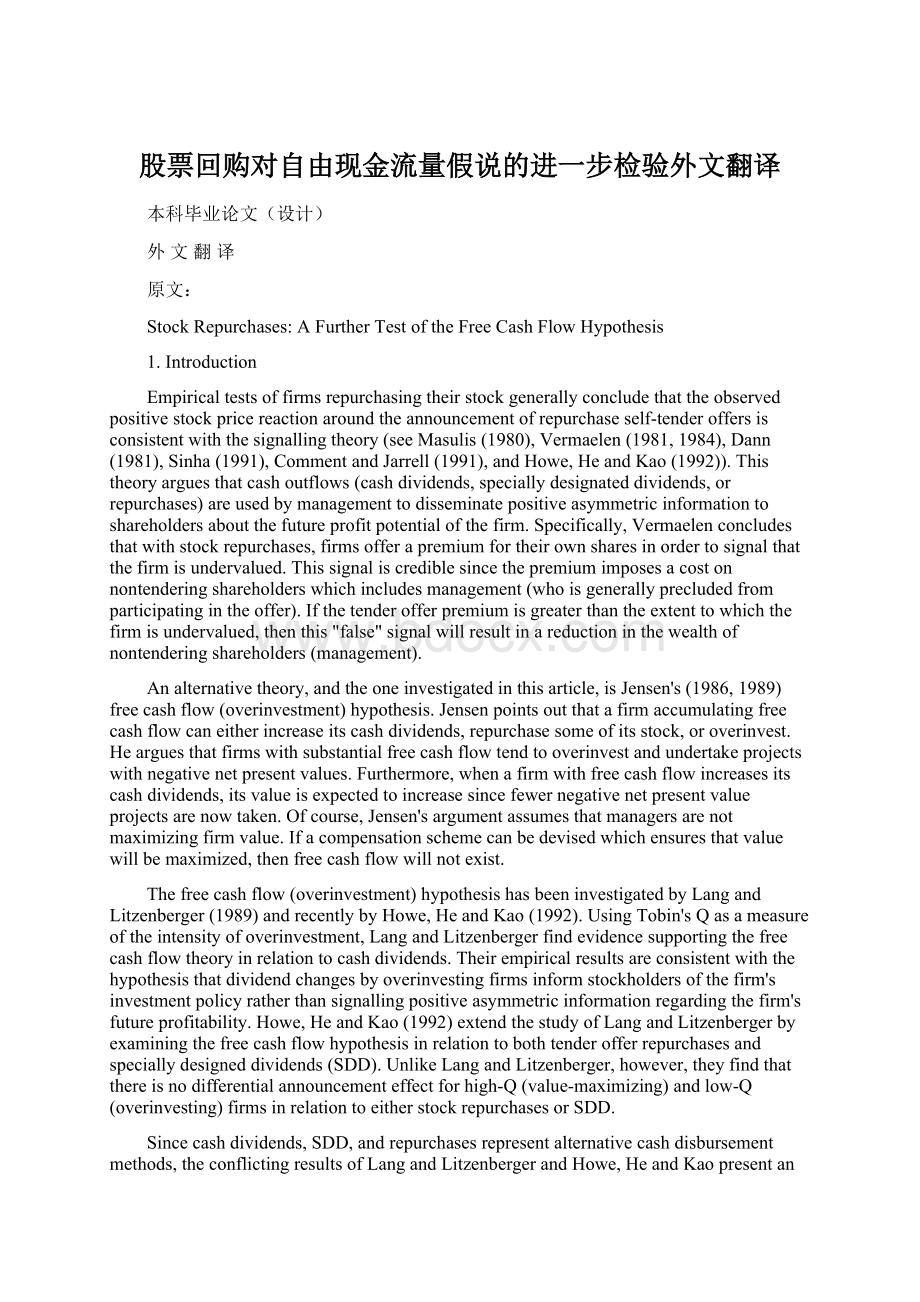股票回购对自由现金流量假说的进一步检验外文翻译Word文档格式.docx
《股票回购对自由现金流量假说的进一步检验外文翻译Word文档格式.docx》由会员分享,可在线阅读,更多相关《股票回购对自由现金流量假说的进一步检验外文翻译Word文档格式.docx(7页珍藏版)》请在冰豆网上搜索。

原文:
StockRepurchases:
AFurtherTestoftheFreeCashFlowHypothesis
1.Introduction
Empiricaltestsoffirmsrepurchasingtheirstockgenerallyconcludethattheobservedpositivestockpricereactionaroundtheannouncementofrepurchaseself-tenderoffersisconsistentwiththesignallingtheory(seeMasulis(1980),Vermaelen(1981,1984),Dann(1981),Sinha(1991),CommentandJarrell(1991),andHowe,HeandKao(1992)).Thistheoryarguesthatcashoutflows(cashdividends,speciallydesignateddividends,orrepurchases)areusedbymanagementtodisseminatepositiveasymmetricinformationtoshareholdersaboutthefutureprofitpotentialofthefirm.Specifically,Vermaelenconcludesthatwithstockrepurchases,firmsofferapremiumfortheirownsharesinordertosignalthatthefirmisundervalued.Thissignaliscrediblesincethepremiumimposesacostonnontenderingshareholderswhichincludesmanagement(whoisgenerallyprecludedfromparticipatingintheoffer).Ifthetenderofferpremiumisgreaterthantheextenttowhichthefirmisundervalued,thenthis"
false"
signalwillresultinareductioninthewealthofnontenderingshareholders(management).
Analternativetheory,andtheoneinvestigatedinthisarticle,isJensen'
s(1986,1989)freecashflow(overinvestment)hypothesis.Jensenpointsoutthatafirmaccumulatingfreecashflowcaneitherincreaseitscashdividends,repurchasesomeofitsstock,oroverinvest.Hearguesthatfirmswithsubstantialfreecashflowtendtooverinvestandundertakeprojectswithnegativenetpresentvalues.Furthermore,whenafirmwithfreecashflowincreasesitscashdividends,itsvalueisexpectedtoincreasesincefewernegativenetpresentvalueprojectsarenowtaken.Ofcourse,Jensen'
sargumentassumesthatmanagersarenotmaximizingfirmvalue.Ifacompensationschemecanbedevisedwhichensuresthatvaluewillbemaximized,thenfreecashflowwillnotexist.
Thefreecashflow(overinvestment)hypothesishasbeeninvestigatedbyLangandLitzenberger(1989)andrecentlybyHowe,HeandKao(1992).UsingTobin'
sQasameasureoftheintensityofoverinvestment,LangandLitzenbergerfindevidencesupportingthefreecashflowtheoryinrelationtocashdividends.Theirempiricalresultsareconsistentwiththehypothesisthatdividendchangesbyoverinvestingfirmsinformstockholdersofthefirm'
sinvestmentpolicyratherthansignallingpositiveasymmetricinformationregardingthefirm'
sfutureprofitability.Howe,HeandKao(1992)extendthestudyofLangandLitzenbergerbyexaminingthefreecashflowhypothesisinrelationtobothtenderofferrepurchasesandspeciallydesigneddividends(SDD).UnlikeLangandLitzenberger,however,theyfindthatthereisnodifferentialannouncementeffectforhigh-Q(value-maximizing)andlow-Q(overinvesting)firmsinrelationtoeitherstockrepurchasesorSDD.
Sincecashdividends,SDD,andrepurchasesrepresentalternativecashdisbursementmethods,theconflictingresultsofLangandLitzenbergerandHowe,HeandKaopresentanempiricalpuzzle.Toshedlightonthispuzzle,wepartitionoursampleoffirmsrepurchasingtheirstockviaaself-tenderofferintothreegroupsbasedonthesourceofthefirms'
freecashflows.Evidenceconsistentwiththefreecashflowhypothesisisfound.
Thearticleisstructuredasfollows:
section2describesthemethodologyfordeterminingthesourceofthefreecashflow(overinvestment)problemandcompetingexplanations.Section3describesthedata.Theempiricalresultsaregiveninsection4.Concludingremarksarepresentedinsection5.Analternativetestofthesignallingtheoryispresentedintheappendix.
2.Methodology
Toclarifytheimplicationsofthefreecashflow(overinvestment)andsignallingtheories,denotethevalueofthefirmbyVandtheinvestedcapitalbyK.ValuemaximnizationoccurswheneverdV/dK=1.OverinvestingimpliesthatdV/dK<
1.Supposethatafirmranksitsinvestmentprojectsintermsofprofitability,forexample,bytheexpectedinternalrateofreturn(IRR).ThendV/dK=1impliesthatatthemarginp=R,wherepisthefirm'
scostofcapitalandRistheexpectedinternalrateofreturn.Suchanequilibriumdictateshowmuchofthefirm'
savailableresourcesshouldbemaintainedforreinvestmentandhowmuchshouldbedistributedtostockholders.Freecashflowsareprecludedinsuchanequilibrium.
Forsimplicityandwithoutlossofgenerality,assumeaone-periodmodelwherethefirminvestsattoandatt1thefirmreinvestsanddistributesdividends.Considerthefollowingthreescenarios:
A.Attimet(whereto<
t<
tl),theagentpossessespositiveasymmetricinformationregardingthefirm'
sfutureprofitability.Thisasymmetricinformationcaneitherberegardingtheperformanceofexistingcapitalornewprojectswhichare